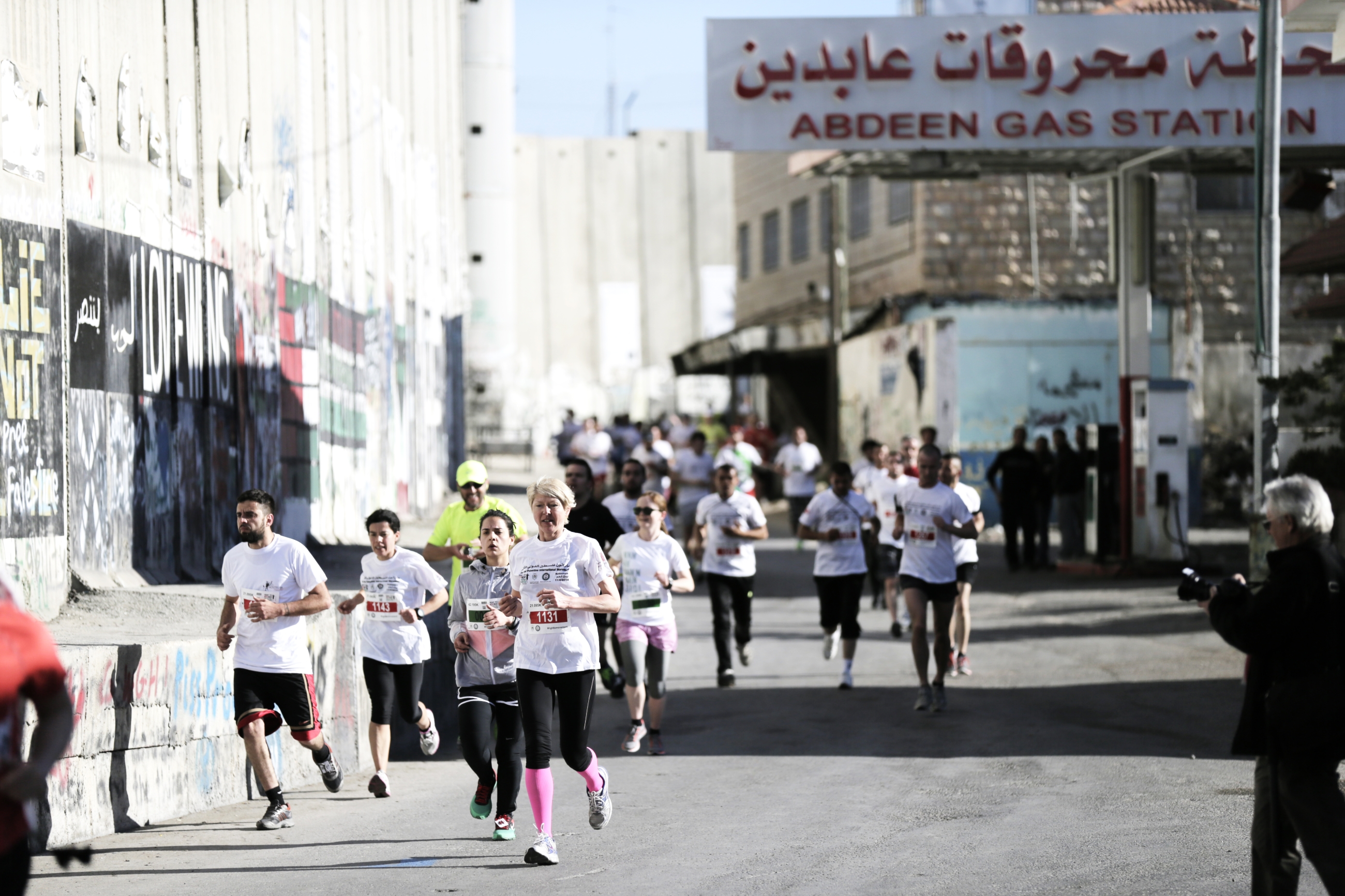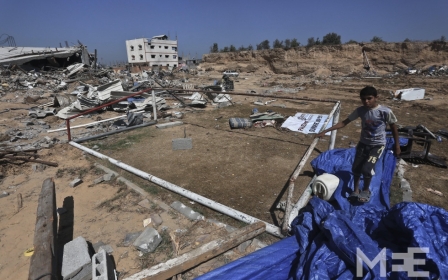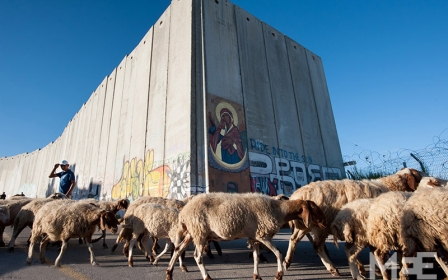Running for rights and resistance

RAMALLAH: Diala dismissed her cousin’s invitation to run in Palestine’s first marathon offhand. “I said, ‘don't be ridiculous. What marathon? What are you saying? A marathon in Palestine?’”
Two years on, having become one of Palestine’s most dedicated runners and a coordinator of Right to Movement, Diala sees that same disbelief in others: “when you’re running on the streets you’ll see people in cars staring at you, thinking ‘what’s wrong with these people? What are they running from?’” She explains her motivation for running to Middle East Eye saying, while “others run to get a taxi or from the rain, we run for our right to movement.”
Right to Movement has evolved from an informal jogging group in Bethlehem to an international organisation, boasting running communities in Bethlehem, Jerusalem, Ramallah, and abroad in London, New York, Denmark, Ghana, San Francisco. Communities in Croatia, Berlin, and Beirut are taking root. It’s looking hopefully to Gaza too.
It was spearheaded by two Danes with the crucial help of a Palestinian cohort. Co-founder Signe Fischer came to Palestine in 2009 to work on advocacy having studied human development, conflict, and politics. But, as she told MEE, “I didn’t think we were doing a very good job.” She believes that many NGOs operating in the region are largely ineffective, their work limited to “administering crisis.”
“We always look to the big political systems [to implement change] - the US, the UK, the UN, EU,” Signe told MEE, “but they’re not moving before people are moving. With Right to Movement, we’re hoping we can get many more people to take action.”
Right to Movement is grounded in that very simple action-taking principle: that everyone has the right to movement, and people should take ownership of that right by running. The organisation aspires to create a platform for people in Palestine and globally to take ownership of this and other fundamental rights.
Its Ramallah community has around 30 regular participants who meet for 5 and 10 kilometre runs two or three times weekly. The runs are as much social events as they are about exercising or taking ownership of rights. Runners are split equally between male and female, local and international. Right to Movement’s slogan is, “we run to tell a different story.” But what is that story?
According to Faris, 25, a Palestinian runner and Right to Movement coordinator, “it’s a different story from the war, suffering, terror. It’s a positive story, not about a siege or about soldiers breaking into your house.” For Diala, “It’s a story about how we use our space, or the space we have left in our land.”
According to B’Tselem, The Israeli Information Centre for Human Rights in the Occupied Territories, “Israel imposes restrictions on Palestinian travel within the West Bank, obstructs access to areas where it seeks greater control, and prevents travel between the Gaza Strip and the West Bank. It also reflects the view that freedom of movement is not an inalienable right but a privilege that Israel can choose to bestow or withhold.”
For example: “I came from Bethlehem yesterday,” says Faris “it took me two hours! On a road that can take forty-five minutes. Why? Because the Israelis are making it hard to cross through checkpoints.” When Israel’s authorities denied Diala a work permit in Jerusalem, she was unable to continue working with the architecture firm that had hired her there.
This restriction of movement within Palestine induces, according to Diala and Faris, feelings of “living under siege” and perennial “frustration.”
Social media plays an important role in telling Right to Movement’s story. Its communities dispersed across the globe curate Facebook, Twitter, and Instagram accounts to share their success and encourage new participants.
The organisation has grown in Palestine largely by “word of mouth,” and in tandem with social media. As Faris half-jokes, “You’re not embarrassed to invite someone to come and run with you, it’s not like you’re asking them to go out on a date or something.”
The story of Right to Movement is almost inseparable from that of the Palestine Marathon - Right to Movement began, in fact, in 2013 as a training session for Palestine’s inaugural marathon. The marathon - the third being scheduled for March next year - has become Right to Movement’s increasingly popular focal point, its watermark. In 2013, 687 runners participated, but in 2014, that number increased impressively to just under 3000.
As Faris describes, “The [individual] running communities are like rivers, and the Palestine Marathon is the ocean. It all flows there.”
Among the Palestine Marathon and Right to Movement’s chief successes is having encouraged women to participate. “The first marathon had 37 percent female participation and the second had 34 - and that’s way higher than marathons in Copenhagen and Germany,” says Signe.
But obstacles - often cultural - persist. According to Faris, “The problem is with the parents who don’t send their daughters to run - I know of girls from conservative families and for them, it’s not acceptable to run in public.”
“For some, it’s not the running itself,” explains Diala, “it’s the time of running. It’s dark by 7:30 pm, you can’t go out when it’s dark. I get messages, usually from people from more conservative communities, asking if the time can be earlier.”
Despite these obstacles, attitudes are changing. And according to Signe, male runners are especially vocal on the issue. “The guys are focusing much more on women’s participation. It’s a great by-product, that by running with women, the guys saw the challenges women are facing.”
Most agree that Right to Movement is - in some capacity - a form of non-violent resistance. “I think Right to Movement is a good example of non-violent resistance,” says Signe. “It’s a movement that anyone can join. You don’t have reject something, you don’t have to ban anything, you don’t have to fight something physically.”
“In Bethlehem, we’re running in Area C,” answers Diala, “Why do we run there and why do we keep running there? We want to say it’s our land and it’s our right to run on this land. This is a kind of resistance.”
Signe adds, “There shouldn’t be monopoly on resistance. People can resist in different ways.”
Perhaps the most existential issue which Palestine Marathon organisers have addressed, is whether to invite Israeli runners to participate. Faris acknowledges that this has been one of the group’s more divisive challenges, saying, “you will find different opinions on this.”
For Diala, the answer is simple: “Imagine there’s an occupier that occupies your land, and then you want to run peacefully with them. No, of course not. I won’t participate if there are Israelis running.”
In inviting Israelis to run, there are legitimate security concerns to take into consideration, says Faris, “Imagine an Israeli passing through Aida Refugee Camp in Bethlehem, and they know he’s Israeli. Do you think he would survive?”
The day before the first Palestine Marathon in April 2013, Signe phoned the handful of Israeli runners who had signed up to recommend they not come. “That was one of the hardest things I’ve had to do. They wanted to show solidarity, and run for the right to movement of Palestinians, which I think it really important. Signe had hoped the marathon could “go beyond” the entrenched regional conflict. But not so.
However, Israeli runner Elon Gilad would not be deterred the recommendations of the marathon’s organising committee or by the Israeli or Palestinian laws that forbade him from participating in the race. He ran posing as a Canadian and would later write about running the Palestine Marathon in Israeli press.
Mid run, Gilad asked a Palestinian runner whether he “would like to see Israelis running here?” The local answered, “If they run with peace and solidarity, I don’t mind seeing them, but if they have any other goal behind running here I don’t want to see them.”
Not everyone in Israel and Palestine has been supportive of Palestine Marathon’s efforts. “The day before the marathon in 2014,” says Signe, “we received an email from someone claiming to be from Hamas warning they were targeting the marathon. We worked closely with the security on both [Israeli and Palestinian] sides and nothing happened.”
“I also had really angry Israelis writing me asking why I was doing this, trying to convince me I was wrong. The sad thing is, some people think because you're working with Palestinians, you’re an anti-semite. We had people threatening to come, threatening to wear Israeli t-shirts to close down the race, but none of these threats materialised.”
The highs and lows of organising the first Palestine Marathon were documented in a recently released film titled “Palestine Marathon.” It won accolades and nine screenings at the Copenhagen International Documentary Film Festival, and was aired on Danish television. Its filmmakers are planning screenings at festivals internationally.
“We’re especially interested in the Tel Aviv film festival in May,” says Signe “I think this could a really interesting Q and A after the show.”
As preparations for the third Palestine Marathon in March gather momentum, its Danish organisers are taking a back seat: “We believe in transferring ownership [of the Palestine Marathon] to Right to Movement, Palestine,” says Signe. “This is really the way that it should move forward, it should be owned by Right to Movement, Palestine, it shouldn’t be a Danish project.”
And while Right to Movement grows internationally, Signe says, “we’re really trying not to dictate the direction of the organisation, but we are trying to make people use us to tell their own story. We’re letting others shape us.”
New MEE newsletter: Jerusalem Dispatch
Sign up to get the latest insights and analysis on Israel-Palestine, alongside Turkey Unpacked and other MEE newsletters
Middle East Eye delivers independent and unrivalled coverage and analysis of the Middle East, North Africa and beyond. To learn more about republishing this content and the associated fees, please fill out this form. More about MEE can be found here.




